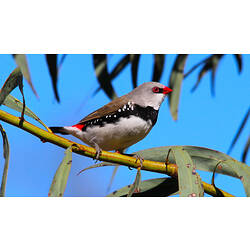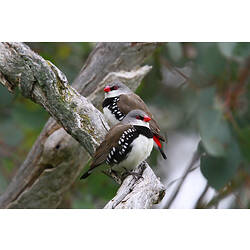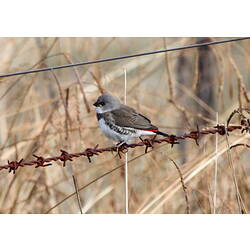General Description
This finch has a bright red bill and a bright red rump. Its iris and eye ring are also red. It has a black stripe between the eye and the bill (loral stripe). The head and back are grey and the underbody is white. It has a thick black breast-band and black flanks, the latter with prominent white spots. The wings are grey-brown. The legs and feet are dark grey. Juveniles are less brightly coloured and have black bills. Maximum size: 13 cm.
Biology
Diamond Firetails are most frequently seen as they hop along the ground foraging for grass seeds. They occasionally feed on invertebrates, leaves or the seeds of other plants. They breed from August to January. A male courts a female by holding a piece of grass in his bill (the grass may be up to 1 m long) and simultaneously bobbing and singing to her. Nests are usually bottle shaped. They are constructed from green grass and sometimes incorporate wool, flowers, hair, twine, leaves, twigs and other materials. Parental duties (collection of nesting material, incubation of the eggs and feeding of the young) are shared by the female and male. Incubation of the 4-6 eggs takes about 2 weeks. The young leave the nest at about three weeks old.
Distribution
South-eastern mainland Australia
Habitat
Woodlands, open forests, grasslands with scattered trees, and other lightly-timbered habitats including farmland; also vegetation along watercourses.
More Information
-
Animal Type
-
Animal SubType
-
Brief Id
Boldly patterned in black, white, red, grey and brown. Red bill and rump; black breast-band; black flanks with white spots.
-
Maximum Size
13 cm
-
Habitats
-
Diet
Omnivore
-
Endemicity
-
Commercial
No
-
Conservation Statuses
CITES: Not listed, FFG Threatened List: Vulnerable, EPBC Act 1999: Vulnerable, IUCN Red List: Least Concern
-
Taxon Name
-
Common Name
Diamond Firetail
-
Kingdom
-
Phylum
-
Subphylum
-
Class
-
Order
-
Family
-
Genus
-
Species Name
guttata





